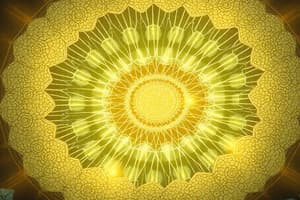Podcast
Questions and Answers
Nuclear membrane irregularities can be a sign of benign transformation.
Nuclear membrane irregularities can be a sign of benign transformation.
False (B)
The nuclear envelope is a single membrane structure composed of lipids and proteins.
The nuclear envelope is a single membrane structure composed of lipids and proteins.
False (B)
Changes in nuclear shape, size, and chromatin pattern cannot aid in cancer diagnosis.
Changes in nuclear shape, size, and chromatin pattern cannot aid in cancer diagnosis.
False (B)
The nucleolus is not involved in RNA processing and transport.
The nucleolus is not involved in RNA processing and transport.
Heterochromatin refers to less condensed, active regions of chromatin.
Heterochromatin refers to less condensed, active regions of chromatin.
Epigenetic modifications do not influence chromatin structure and gene expression.
Epigenetic modifications do not influence chromatin structure and gene expression.
What is the primary function of the perinuclear space in the nuclear envelope?
What is the primary function of the perinuclear space in the nuclear envelope?
What is the characteristic of euchromatin in chromatin structure?
What is the characteristic of euchromatin in chromatin structure?
What is the function of the nucleolus in the nucleus?
What is the function of the nucleolus in the nucleus?
What is the significance of abnormal nuclear morphology in cancer diagnosis?
What is the significance of abnormal nuclear morphology in cancer diagnosis?
What is the composition of the nuclear envelope?
What is the composition of the nuclear envelope?
What is the characteristic of chromatin during mitosis?
What is the characteristic of chromatin during mitosis?
What is the function of the inner membrane of the nuclear envelope?
What is the function of the inner membrane of the nuclear envelope?
What is the significance of nuclear size and irregularity in cancer diagnosis?
What is the significance of nuclear size and irregularity in cancer diagnosis?
Match the following abnormal nuclear morphology features with their descriptions:
Match the following abnormal nuclear morphology features with their descriptions:
Match the following components of the nuclear envelope with their descriptions:
Match the following components of the nuclear envelope with their descriptions:
Match the following features of cancer diagnosis with their descriptions:
Match the following features of cancer diagnosis with their descriptions:
Match the following functions of the nucleolus with their descriptions:
Match the following functions of the nucleolus with their descriptions:
Match the following nuclear envelope functions with their descriptions:
Match the following nuclear envelope functions with their descriptions:
Match the following nuclear morphology features with their implications:
Match the following nuclear morphology features with their implications:
Match the following nucleolar morphology features with their implications:
Match the following nucleolar morphology features with their implications:
Match the following nuclear features with their roles in cancer diagnosis:
Match the following nuclear features with their roles in cancer diagnosis:
Flashcards are hidden until you start studying
Study Notes
Nuclear Morphology
- Shape and Size: Nucleus shape and size can be indicative of cellular health and disease state
- Nuclear-cytoplasmic ratio: Abnormal ratios can indicate cancer or other diseases
- Nuclear membrane irregularities: Can be a sign of malignant transformation
Nuclear Envelope
- Composition: Double membrane structure composed of lipids and proteins
- Function: Regulates nuclear transport, supports cellular signaling, and maintains nuclear shape
- Abnormalities: Can be indicative of cancer, neurodegenerative diseases, or laminopathies
Cancer Diagnosis
- Nuclear morphology: Changes in nuclear shape, size, and chromatin pattern can aid in cancer diagnosis
- Nuclear-to-cytoplasmic ratio: Increased ratio can indicate malignancy
- Immunohistochemistry: Staining techniques can identify specific nuclear proteins for cancer diagnosis
Nucleolus Function
- Ribosome synthesis: Site of ribosome synthesis and assembly
- RNA processing: Involved in RNA modification, processing, and transport
- Stress response: Plays a role in cellular stress response and adaptation
Chromatin Structure
- Euchromatin: Less condensed, active regions of chromatin
- Heterochromatin: More condensed, inactive regions of chromatin
- Epigenetic modifications: Histone modifications and DNA methylation influence chromatin structure and gene expression
Nuclear Morphology
- Abnormal nuclear shape and size can indicate cellular health issues or diseases
- Altered nuclear-to-cytoplasmic ratio can be a sign of cancer or other diseases
- Irregularities in the nuclear membrane can indicate malignant transformation
Nuclear Envelope
- The nuclear envelope is a double membrane structure composed of lipids and proteins
- It regulates nuclear transport, supports cellular signaling, and maintains nuclear shape
- Abnormalities in the nuclear envelope can be indicative of cancer, neurodegenerative diseases, or laminopathies
Cancer Diagnosis
- Changes in nuclear shape, size, and chromatin pattern can aid in cancer diagnosis
- An increased nuclear-to-cytoplasmic ratio can indicate malignancy
- Immunohistochemistry staining techniques can identify specific nuclear proteins for cancer diagnosis
Nucleolus Function
- The nucleolus is the site of ribosome synthesis and assembly
- It is involved in RNA modification, processing, and transport
- The nucleolus plays a role in cellular stress response and adaptation
Chromatin Structure
- Euchromatin is the less condensed, actively transcribed regions of chromatin
- Heterochromatin is the more condensed, inactive regions of chromatin
- Histone modifications and DNA methylation influence chromatin structure and gene expression
Nuclear Morphology
- Normal nucleus has a round to oval shape, smooth contour, evenly distributed chromatin, and a single central nucleolus.
- Abnormal nucleus has an irregular shape, indented or notched contour, clumped or uneven chromatin distribution, and multiple or irregularly shaped nucleoli.
Nuclear Envelope
- The nuclear envelope is a double membrane structure surrounding the nucleus, composed of an inner membrane, outer membrane, and perinuclear space.
- Functions of the nuclear envelope include regulating molecule movement in and out of the nucleus and providing structural support to the nucleus.
Chromatin Structure
- Chromatin is a complex of DNA and histone proteins, with two main structures: euchromatin (lightly packed, active chromatin) and heterochromatin (densely packed, inactive chromatin).
- Chromatin condenses during mitosis and is dispersed during interphase.
Nucleolus Function
- The nucleolus is a non-membranous region within the nucleus responsible for ribosome synthesis, assembly of ribosomal subunits, ribosomal RNA storage, and regulating cell growth and proliferation.
Cancer Diagnosis
- Abnormal nuclear morphology is a hallmark of cancer cells, characterized by increased nuclear size and irregularity, chromatin clumping, and multiple or irregularly shaped nucleoli.
- Nuclear morphology is used in conjunction with other diagnostic techniques to diagnose cancer and distinguish between benign and malignant lesions.
Nuclear Morphology
- Nuclear size and shape vary depending on cell type and function
- Normal nuclei are round or oval with a smooth membrane
- Abnormal nuclear morphology can indicate disease, including:
- Nuclear pleomorphism (varied size and shape)
- Nuclear hyperchromasia (increased staining intensity)
- Nuclear fragmentation (nuclear breakdown)
Nuclear Envelope Structure
- The nuclear envelope is a double membrane structure surrounding the nucleus
- Composed of outer nuclear membrane, inner nuclear membrane, and nuclear pore complexes
- The outer nuclear membrane is continuous with the endoplasmic reticulum
- The inner nuclear membrane is lined with nuclear lamina
- Nuclear pore complexes allow for exchange of molecules between nucleus and cytoplasm
Nuclear Envelope Function
- The nuclear envelope regulates nuclear transport and gene expression
- It maintains nuclear shape and structure
Cancer Diagnosis
- Nuclear morphology is a crucial diagnostic feature in cancer diagnosis
- Abnormal nuclear features can indicate malignant transformation, including:
- Nuclear atypia (abnormal nuclear shape and size)
- Nuclear hyperchromasia
- Increased nuclear-to-cytoplasmic ratio
- Histopathological examination of nuclear morphology helps diagnose and grade tumors
Nucleolus Function
- The nucleolus is a region within the nucleus where ribosome synthesis occurs
- It is involved in ribosome biogenesis, RNA synthesis, and processing
- The nucleolus stores ribosomal RNA and proteins
- Nucleolus morphology can indicate cellular activity and stress, including:
- Nucleolar hypertrophy (enlargement) in response to increased cellular activity
- Nucleolar fragmentation in response to cellular stress or apoptosis
Studying That Suits You
Use AI to generate personalized quizzes and flashcards to suit your learning preferences.




